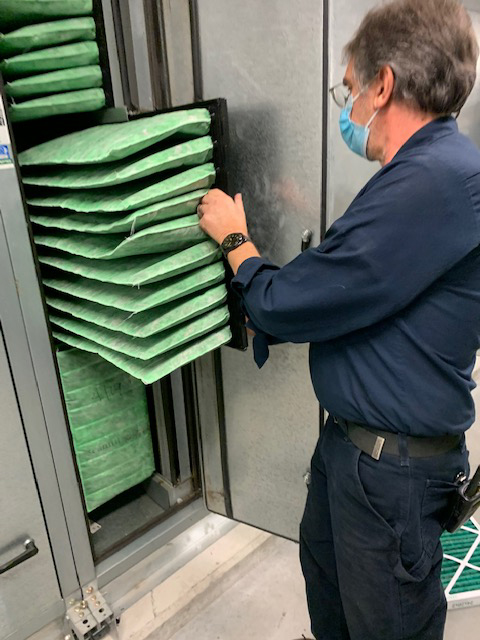Bowdoin’s Investment to Improve Ventilation Key to Safe and Healthy Campus Buildings
By Bowdoin NewsWhile the understanding of how the virus that causes COVID-19 spreads continues to evolve, evidence clearly suggests that transmissions are more likely to occur in enclosed spaces with poor ventilation.

Bowdoin has prioritized enhanced ventilation in its campus buildings and is tagging rooms as “off-limits” for in-person teaching and gatherings when air flow does not meet recommended standards.
“We are screening for spaces that already exceed industry recommendations and then targeting enhancements for spaces that fall just short,” says Senior Vice President for Finance and Administration Matthew Orlando.
In consultation with Integrated Energy Systems Bowdoin Facilities Management has surveyed more than 250 rooms and spaces across campus to establish baseline data for air flow and filtration.
“In many cases, it has been easy to rebalance the existing system or to install a better filter to improve the score,” Orlando says.
“But there are some situations—for example, where there is no mechanical ventilation or where the system was not designed to accept a higher-grade filter—that are much more challenging.”
In classrooms, many experts recommend at least four air changes per hour, meaning the air volume of the room is replaced every fifteen minutes with new supply air, but according to Orlando, the quality of each air change is as important as the number of changes.
“We are looking for clean air changes,” he says. “If most of the supply supporting those air changes is recirculated air, then the grade of the filter becomes a critical factor.“
The College will allow multiple-person occupancy of a space, subject to six-foot distancing, in cases where at least one of the air changes per hour comes 100 percent from outside air.
If that 100-percent-outside air criterion is not met, and the air supply is predominantly recirculated air, the College requires a filter value of at least MERV 13.
Some background on filter ratings: A MERV (minimum efficiency reporting value) rating of thirteen is more than 90 percent efficient in filtering particles that are 3–10 microns (1/1000th of a millimeter) in size, according to the US Environmental Protection Agency.
Following work done this summer and fall by the College’s mechanical services department, roughly two-thirds of the College’s classrooms and lecture halls meet the ventilation criteria. For the rooms that pass, the limiting factor then becomes six-foot physical distancing.
“In a normal year, we have more than forty classrooms that can support course enrollments of twenty or more,” Orlando says.
“This year, based on our ventilation screening and distancing criteria, that number is down to eight, so we have to think creatively about using nontraditional but well-ventilated spaces, like Kanbar Auditorium, to increase options for faculty who want to teach in-person in the spring.”
For spaces that have some, but not enough, outside airflow, portable room air cleaners (RAPs) can be a viable solution. The College is in the process of ordering a large number of RAPs with HEPA filters and ultraviolet light sanitization to be deployed in classrooms, workrooms, and other social spaces around campus that were closed to the campus community this fall.
“Ventilation is not something I ever expected to be in the weeds on—but it is an obsession now,” Orlando says.
“You can’t, in good conscience, ask someone to teach or learn in a room where the only source of fresh air is cracking the window on a subzero day in February.”



